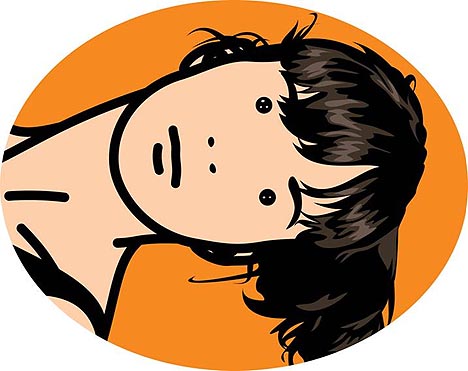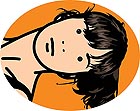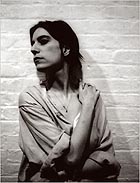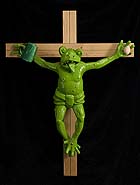
translated and summarized by: Liz Wollner-Grandville,
English summaries July 14 - 20
MAK-Applied Arts/Contemporary Art: Julian Opie – Recent works
Manga world of art history
Parameters for 21st century art are devised here. Pop Art offers a conceptual background for these outmost simplified picture messages, which hold up well against the inexorable speed at which information is distributed by extreme reduction. The pictogram related works by the British artist Julian Opie are charged with difficult art historical references mixed with a playful circumvention of semantic conventions.
Opie’s works, exhibited on the top floor of the MAK, are characterized by the reduction of individual features to a minimum; they include elements from comic strips and Pop Art. His work can be divided into the traditions of art history: landscapes, portraits, and nudes, and can be interpreted both historically as well as by his production methods.
Opie’s main means of expression are drawings and their transformation into the parallel worlds of manga, light-, media-, and spatial installations, stylistic examples of art history, and, last but not least, into iconoclastic comments on the symbolic language of the consumer-world and the reification of bodies.
Julian Opie is presented as a brand – mainly on account of his concentration on the extremely emblematic. Admittedly the artist takes on a kind of identity political about-face, by allowing his figures character and individuality. But the artist also shows his ability of reinterpreting and transforming works created by 19th century Japanese masters. These works are part of an unusually broad and deep adaptation of the characteristics and history behind a drawing. The essential texts by Timothy Clark in the catalogue broaden the view on Julian Opie’s oeuvre, which – on account of its simplicity - one might otherwise overlook.
MAK-Applied Arts/Contemporary Art
1010 Vienna, Stubenring 5, until 21. 09. 2008
www.mak.at
Whitney Museum of American Art: Polaroids: Mapplethorpe
Fast love
In 2003 Sylvia Wolf, curator of the Whitney Museum, discovered the 1.500 Polaroid photos taken by the young Robert Mapplethorpe between the years 1970 and 1975. The current exhibit at the Whitney Museum of American Art brings together a selection of his work, some of which has never been shown before.
The show presents a mixture of elegant as well as shocking depictions of sexual obsessions - provoking so many scandals in later years - as well as self portraits and portraits of friends.
These small photographs, in contrast to Mapplethorpe's the studio-staged images of the 80’s, have a sensitive impact on the viewer. Among them portraits of Patti Smith and Marianne Faithful, which initiate an unexpected tenderness and vulnerability. His Polaroids can be compared to a huge sketchbook: full of figure studies and bizarre still lifes.
There are two nostalgic aspects to this exhibit: first, in view of the fact that Polaroid cameras are no longer being produced since March 2008, these photos are a homage to instant photography - nowadays substituted by video and digital photography. And second, Mapplethorpe’s work reminds of how light-heartedly homosexuality was lived before AIDS even existed.
Mapplethorpe died at the early age of 42 as a result of an HIV infection. We don’t know how the artist would have dealt with the opportunities offered by digital technologies, but most probably he would have been fascinated it. He was not a friend of time-consuming work processes. “If I had to do something, which takes two weeks, I would lose my enthusiasm. It would become something like lab work, and my love for the whole thing would disappear”, he once said.
Whitney Museum of American Art
10001 New York, 945 Madison Avenue, until 07. 09. 2008
www.whitney.org
Schaulager: Andrea Zittel, Monika Sosnowska – 1:1
Kokon politikon
The current exhibit at the Schaulager in Basel is dedicated to the artists Andrea Zittel and the Monika Sosnowska. Their works deal with architecture and fit very well into the rather clean and commonplace interior of the Schaulager.
The American artist Zittel shows what remains, when the façade is removed: a container, a place for retreat and cocooning or maybe even for the survival of the species. Her Survival Kits have a connotation of catastrophe, are conceptualised as swimming islands, as maisonettes or tropical huts, but always only for one single person: the artist herself.
Monika Sosnowska, the artist from Poland, is also known for her claustrophobia-like work, but in contrast to Zittel, she has made paranoia to the main topic. She repeated her Venice Biennale 2007 success, which was a real show-stopper: she jammed a metal scaffold between the floor and the ceiling of the typical Eastern Bloc construction made of prefabricated concrete slabs. And there is a hallway, which literally drives this discourse into a corner.
The human being: the Kokon politikon (political cocoon). The onlooker is encouraged to adjust to the conditions in a capsule, the individual version of a steel encasement, symbolising our modern day and age. This double show in Basel leads to the one-man show for everyone. And the façade arouses attention.
Schaulager
4142 Münchenstein, Ruchfeldstrasse 19, until 21. 09. 2008
www.schaulager.org
Museion – Museum für moderne und zeitgenössische Kunst: Peripheral vision and collective body
Intention or coincidence?
The opening of a museum and the communication
Bad news can be good news – or at least good advertisement.
If this is the way Corinne Diserens, director of the museion, the new museum of modern and contemporary art in Bozen, assessed the situation, she must have been extremely happy. After all - since the opening of the museum on May 24, there has been a heated debate about Martin Kippenberger’s art work.
It is a well-known fact that topics connected to sexuality or religion prompt most people to voice their opinion. Especially if elections are just around the corner – as is the case in the autonomous province of Southern Tyrol. The object of contention is Kippenberger’s work titled “Feet first” (Zuerst die Füsse): a green frog nailed to a wooden cross, in its left a beer mug and in its right an egg. The frog was positioned over the entrance to the museum shop, and not been taken down, (as demanded) but veiled. On either side of the frog: articles published about the “frog scandal” and the opening of the museum – the museum is communicating with texts written by others.
But the scandal makes people forget what is really going on. It’s all is about the opening of a museum, which is aiming at becoming a well-known international venue. It is operated by a foundation, under participation of an association and the province of Bozen.. The appealing cube has a length of 54, a height of 25 and a width of 23 meters. The building was planned by the Berliner-based architects KSV Krüger Schuberth Vandreike and offers numerous rooms on six floors. So far 35 million euros were invested into the project.
The museum fulfils many requirements for holding fabulous exhibits, and its technical infrastructure is cleverly thought out. However, it is not enough to only provide an exhibit title and a folder with a short explanation and a list of more than 200 artists. 300 objects should not simply be hung or positioned in a huge space, accompanied by slide shows and videos without really “guiding” the visitors. Small, nearly hidden cards on the walls, with the name of the artist and the artwork plus the year it was created, are not much good, and leave many visitors puzzled. No intention by the curator. Nothing, but “Please don’t touch.”
Museion – Museum für moderne und zeitgenössische Kunst
39100 Bozen, Dantestrasse 1, until 21. 09. 2008
www.museion.it
Mehr Texte von translated and summarized by: Liz Wollner-Grandville


 Teilen
Teilen





